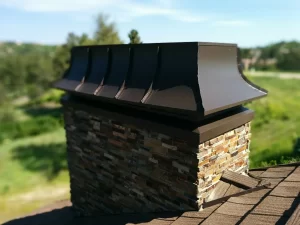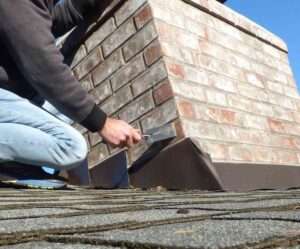Water damage can wreak havoc on your chimney, leading to costly repairs and potential safety hazards. As a homeowner, it is crucial to take proactive measures to prevent water infiltration and preserve the integrity of your chimney. From inspecting for cracks and gaps to redirecting downspouts away from the chimney, there are various steps you can take to safeguard this crucial structure.
In this discussion, we will explore a range of effective strategies that will not only protect your chimney from water damage but also enhance its lifespan. So, let’s delve into these key preventative measures and ensure the longevity of your chimney.

Inspect for Cracks and Gaps
When inspecting your chimney for potential water damage, it is crucial to thoroughly examine the structure for any cracks or gaps that may compromise its integrity. These cracks and gaps can allow water to seep into the chimney, leading to further damage over time.
To prevent this, it is important to regularly inspect and repair mortar joints, as they can deteriorate over time due to exposure to weather elements. Repairing mortar joints involves removing the damaged mortar and replacing it with fresh mortar.
Additionally, identifying chimney leaks is essential in preventing water damage. Look for signs such as water stains on the ceiling or walls near the chimney, dampness or musty odor in the attic, or water pooling at the base of the chimney.
Install a Chimney Cap
To further safeguard your chimney from water damage, the installation of a chimney cap is a crucial step in preventing moisture infiltration. A chimney cap is a protective covering that is placed on top of the chimney opening. Here are four benefits of installing a chimney cap:
- Prevents water entry: A chimney cap acts as a barrier, preventing rainwater, snow, and ice from entering the chimney. This helps to avoid water damage to the chimney structure and interior.
- Keeps out animals and debris: Chimney caps are designed to keep out animals like birds, squirrels, and raccoons, as well as debris such as leaves, twigs, and branches. This prevents blockages and potential fire hazards.
- Reduces downdrafts: A properly installed chimney cap can help reduce downdrafts by creating a barrier against wind. This helps to improve the efficiency of the fireplace or wood-burning stove.
- Enhances chimney aesthetics: Chimney caps come in various styles and materials, allowing you to choose one that complements the overall look of your home.
Different types of chimney caps include single-flue caps, multi-flue caps, and top-mount caps. Each type offers specific features and benefits, so it’s important to choose the right one for your chimney.
Apply a Water Repellent Sealant
Applying a water repellent sealant to your chimney is a crucial step in protecting it from water damage and prolonging its lifespan. A well-applied sealant can effectively prevent water from seeping into the bricks and mortar of your chimney, which can cause significant damage over time.
To ensure the effectiveness of the sealant application, there are some best practices to follow. Firstly, it is important to thoroughly clean the chimney surface, removing any dirt, debris, or existing sealant.
Next, choose a high-quality water repellent sealant that is specifically designed for masonry surfaces. Follow the manufacturer’s instructions for application, ensuring that the sealant is evenly spread and covers the entire chimney surface. It is recommended to apply multiple coats for maximum protection.
Regular inspection and reapplication of the sealant is essential to maintain its effectiveness in preventing water damage. By following these best practices, you can effectively protect your chimney from water damage and extend its lifespan.
Maintain Proper Chimney Crown
Proper maintenance of the chimney crown is essential in preventing water damage and ensuring the longevity of your chimney. The chimney crown, also known as the chimney cap, is the topmost part of the chimney that protects it from rain, snow, and other elements.
Here are four important steps to maintain your chimney crown:
- Regular Inspection: Inspect the Chimney Crown at least once a year for any cracks, holes, or signs of wear and tear. Catching these issues early can prevent further damage.
- Cleaning: Remove any debris, such as leaves or twigs, that may accumulate on the chimney crown. This will prevent water from pooling and causing damage.
- Sealing: Apply a water repellent sealant to the chimney crown to protect it from moisture. This will prevent water from seeping into the chimney and causing damage.
- Repairing: If you notice any cracks or damage to the chimney crown, it is essential to repair them promptly. Ignoring these issues can lead to further water damage and costly repairs.
Ensure Proper Gutter Maintenance
Regular gutter maintenance is crucial for preventing water damage to your chimney. Properly functioning gutters play a vital role in directing rainwater away from your chimney, preventing it from seeping into the masonry and causing costly damage.
To ensure your gutters are effectively diverting water, regular gutter cleaning is necessary. Debris such as leaves, twigs, and dirt can accumulate and clog the gutters, obstructing the flow of water. This can lead to overflow and water spilling onto the chimney, causing potential damage.
Additionally, gutter repair should be undertaken promptly to fix any leaks, loose joints, or sagging gutters that can compromise their efficiency.
Redirect Downspouts Away From the Chimney
To further protect your chimney from water damage, it is essential to redirect downspouts away from the structure. Downspouts play a crucial role in channeling water away from the roof and foundation of your home. However, if they are directing water towards your chimney, it can lead to moisture penetration and damage over time. By redirecting downspouts away from the chimney, you can prevent water from pooling around its base and seeping into the masonry.
Here are four steps to effectively redirect downspouts:
- Install downspout extensions: Attach extensions to your downspouts to direct water at least five feet away from the chimney.
- Slope the extensions: Ensure that the extensions are sloped away from the chimney to promote proper water drainage.
- Use splash blocks: Place splash blocks at the end of the downspout extensions to prevent erosion and direct water away from the chimney’s foundation.
- Maintain clean gutters: Regularly clean and maintain your gutters to prevent clogs and ensure proper water flow.
Monitor and Repair Flashing
Flashing, a crucial component of chimney maintenance, requires consistent monitoring and timely repair to prevent water damage and ensure the structural integrity of the chimney. Flashing is typically made of metal, such as aluminum or copper, and is installed around the chimney to create a watertight seal between the chimney and the roof. Over time, flashing can become damaged or deteriorate due to exposure to the elements, leading to water leaks and potential structural issues.
To monitor the condition of the flashing, it is important to inspect it regularly for any signs of damage or wear. Look for cracks, gaps, or rust spots that may indicate a need for repair. Pay close attention to the areas where the flashing meets the chimney and the roof, as these are common areas for leaks to occur.
If any issues are detected during the monitoring process, it is essential to promptly repair the flashing to prevent further damage. Depending on the extent of the damage, repairs may involve sealing cracks or gaps with a waterproof sealant or replacing damaged sections of the flashing altogether. It is recommended to hire a professional chimney technician to ensure proper repairs are made and to minimize the risk of future water damage.
Consider Waterproofing the Chimney
Proactively safeguarding your chimney against water damage extends beyond monitoring and repairing the flashing; considering waterproofing the chimney is an essential step to maintain its longevity and protect it from moisture infiltration. Waterproofing provides numerous benefits, including preventing water leakage, reducing the risk of structural damage, and enhancing the overall efficiency.
Here are four effective methods for waterproofing your chimney:
- Chimney Crown Sealant: Applying a high-quality sealant to the chimney crown creates a protective barrier against water penetration.
- Chimney Cap Installation: Installing a chimney cap keeps out rain, snow, and debris, preventing water from entering the chimney.
- Waterproofing Membrane: A waterproofing membrane can be applied to the exterior of the chimney to provide an additional layer of protection.
- Masonry Water Repellent: Using a masonry water repellent helps repel water and protect the chimney’s bricks from moisture damage.
Conclusion
By regularly inspecting for cracks and gaps, installing a chimney cap, applying a water repellent sealant, and maintaining a proper chimney crown, homeowners can effectively prevent water damage on their chimneys.
Ensuring proper gutter maintenance, redirecting downspouts away from the chimney, and repairing flashing are important steps in preventing water damage.
Finally, considering waterproofing the chimney is another preventive measure that homeowners can take. By following these measures, homeowners can save themselves from costly repairs and ensure the longevity of their chimneys.
As the saying goes, ‘An ounce of prevention is worth a pound of cure.’ Taking these preventive measures will save homeowners from costly repairs and ensure the longevity of their chimneys.
